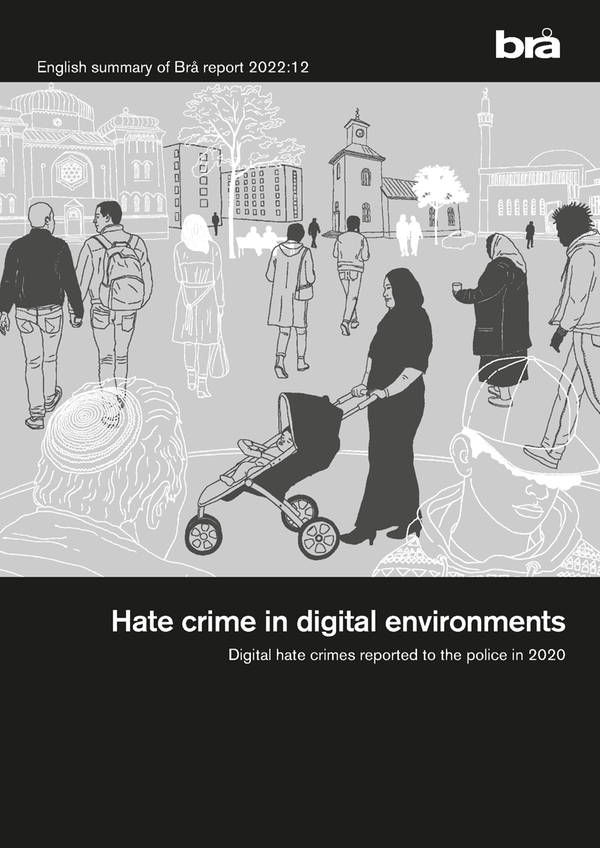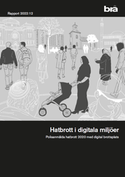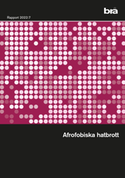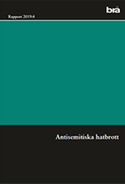Hate crime in digital environments
Digital hate crimes reported to the police in 2020. English summary of Brå report 2022:12
Digital hate crimes are hate crimes that take place in digital environments, such as social media. The aim of this report was to improve the knowledge on digital hate crime.
The data are derived from 489 police reports from 2020 that were marked by the police as involving hate crimes and that, in Brå’s assessment, contained a hate crime motive and had been committed in digital environments.
Summary of the results
Xenophobic and racist hate crime motives were most common
The vast majority of digital hate crimes reported to the police in 2020 took place on social media (41%) or via digital call and communication services1 (34%). Xenophobic and racist hate crime motives were by far the most common (44%), followed by hate crimes against religious groups (27%), LGBTQI-related hate crimes (16%) and unspecified hate crime motives (13%). One characteristic of the digital hate crimes was that the category of hate crimes against religious groups accounted for a larger proportion of the total number of hate crimes than in the regular hate crime statistics (which also include hate crimes in physical environments), and that antisemitic and Islamophobic hate crimes were about equally common among the digital hate crimes, whereas Islamophobic hate crime motives were more common than antisemitic hate crime motives in the regular hate crime statistics (Brå 2021a).
Around half of the police reports involved agitation against an ethnic or national group
The most common category of crime was agitation against an ethnic or national group, which accounted for almost half (47%) of all police reports of digital hate crime. This was followed by unlawful threats (18%), molestation (16%) and defamation (14%). Offences against liberty and a person’s integrity were less common, as were other offence types.
Police Region Central registered most reports per capita
The regions of Stockholm, South and West registered the most police reports involving digital hate crimes in 2020 (27, 19 and 15 percent respectively). When population size was taken into account, Region Central registered the highest number of police reports, around 6 reports per 100 000 inhabitants. Regions West, East and Bergslagen each registered the lowest number of police reports, around 4 reports per 100 000 inhabitants. However, it is important to remember that a police report of a digital hate crime may be registered in one region while the perpetrator (and other potential victims) may be in another region.
Men are victimised more often than women
The victim was most often a natural person (58%) in police reports involving digital hate crimes, but that still leaves many reports (42%) where a natural person had not been victimised, i.e. where the victim was either a legal person2 or not a specific person. The latter applies when the hate crime was directed against a particular group in general, as is the case with agitation against an ethnic or national group.
Among the natural persons victimised, men accounted for a higher proportion of the victims than women (50% and 43% respectively). Women and men were about equally likely to be victimised via digital call and communication services (52% and 50% respectively). However, a higher proportion of women than men were victimised when the digital hate crime occurred at work, e.g., being victimised in the workplace via email or a post on social media (11% and 5% respectively).
Some gender differences in victimisation for different crimes
Among the male victims in the police reports, unlawful threats were the most common category of crime (35%). This was followed by defamation (25%), molestation (19%) and agitation against an ethnic or national group (16%). Among female victims, however, molestation was the most common (39%), followed by defamation (25%), unlawful threats (20%) and agitation against an ethnic or national group (11%). For both male and female victims, crimes against liberty and a person’s integrity and other offence types accounted for a smaller proportion of the police reports involving digital hate crimes.
The perpetrator is often unknown
Among the natural persons victimised, the most common scenario was that the perpetrator was unknown to the victim (66% of police reports). In one sixth (17%) of the police reports, the perpetrator was known to the victim and in 7% of the reports, the perpetrator was a relative of the victim.
Children are sometimes overrepresented among the victims
For the crime categories of molestation, unlawful threats and defamation, the offence code3 provides information on whether the victim was under or over 18 years of age. In all these crime categories, the victim was more likely to be an adult than a child, but when the proportion of children and adults in the population is taken into account, children were overrepresented as victims in the police reports involving molestation. However, in police reports involving defamation, there was an underrepresentation of children as victims, in relation to the proportion of children in the population.
Conclusions
Overall, the characteristics of the digital hate crimes are similar to those found in the regular hate crime statistics for 2020, i.e. including hate crimes that took place in a physical environment (Brå 2021a). As with physical hate crimes, the number of digital hate crimes that go unreported can also be assumed to be high. Given that the digital environment accompanies us wherever we go (in our smartphones, for example) and that hate posts on e.g. social media can be widely disseminated, it is essential that the justice system also takes action against these types of crime. Several initiatives have been taken by both the justice system and civil society organisations. In Region North, for example, the police have an ongoing project involving “online patrolling” as a method for preventing and detecting online crime. It remains to be seen whether this will affect the level of digital hate crime.
About the study
Hate speech in digital environments comes in different forms and affect some social groups more than others, for example people with foreign background, some religious groups and LGBTQI-individuals (Björkenfeldt et al. 2021b, Bladini 2017, Brå 2022a). The prevalence of hate speech online varies depending on the survey, in some surveys it’s significant (Björkenfeldt et al. 2021b). In the end, hate speech causes a lot of fear among users and increases the feeling of limitation when it comes to participation in online debates and discussions. Hate speech also includes criminal offences like different types of digital hate crimes.
Hate crimes are crimes motivated by the perpetrator's prejudice or beliefs about race, colour, nationality, ethnic background, religion, sexual orientation or transgender identity or expression or any other similar circumstance. Hate crimes can be found in all types of crime and can therefore target individuals and groups as well as property, institutions or their representatives (Brå 2021a).
Digital hate crimes are hate crimes that take place in digital environments, such as social media. The aim of this report was to improve the knowledge on digital hate crime. The data are derived from 489 police reports from 2020 that were marked by the police as involving hate crimes and that, in Brå’s assessment, contained a hate crime motive and had been committed in digital environments.
Fakta om publikationen
Författare: Aravella Lejonstad
© Brottsförebyggande rådet 2024
Rapport 2022:12






